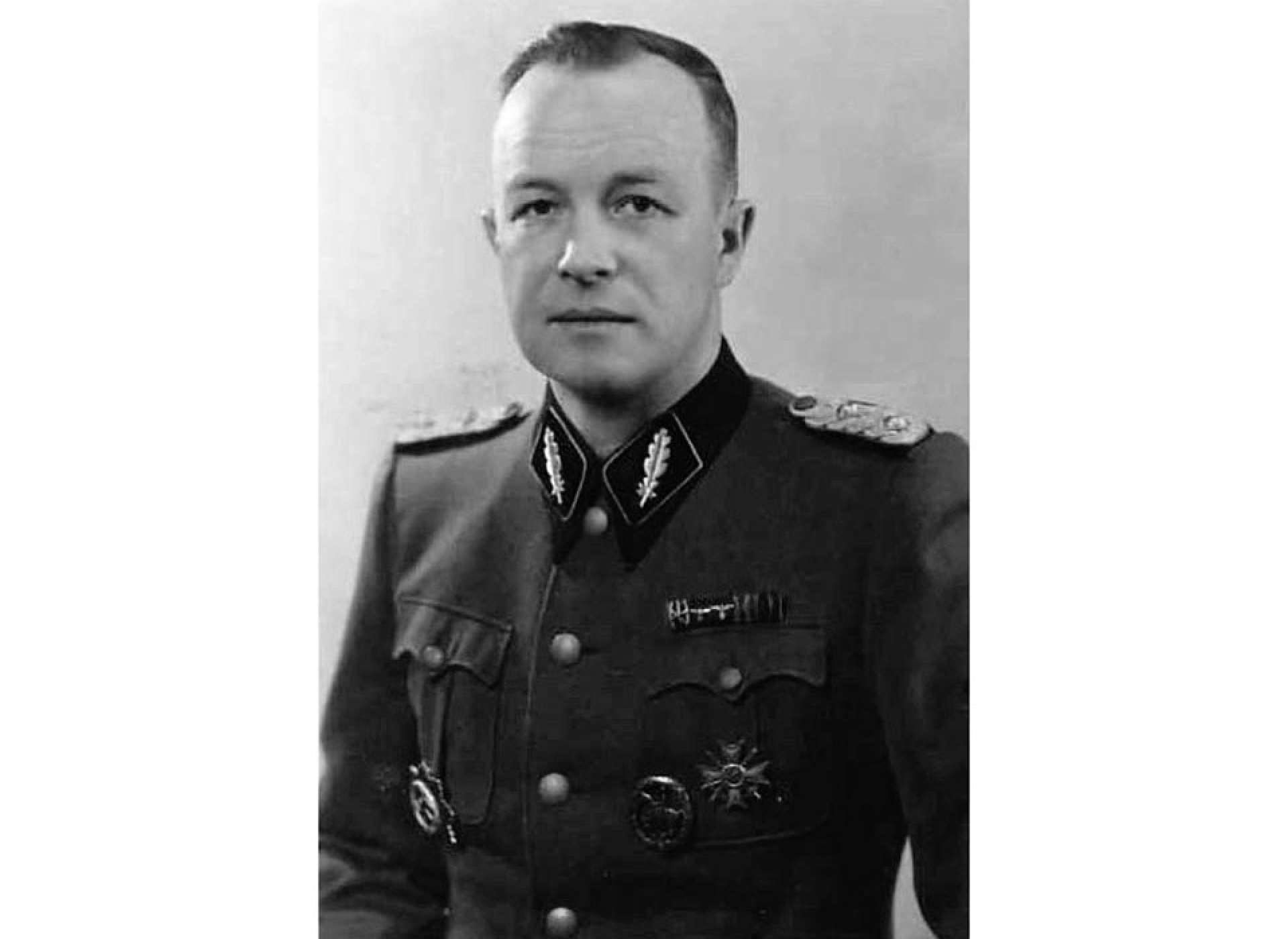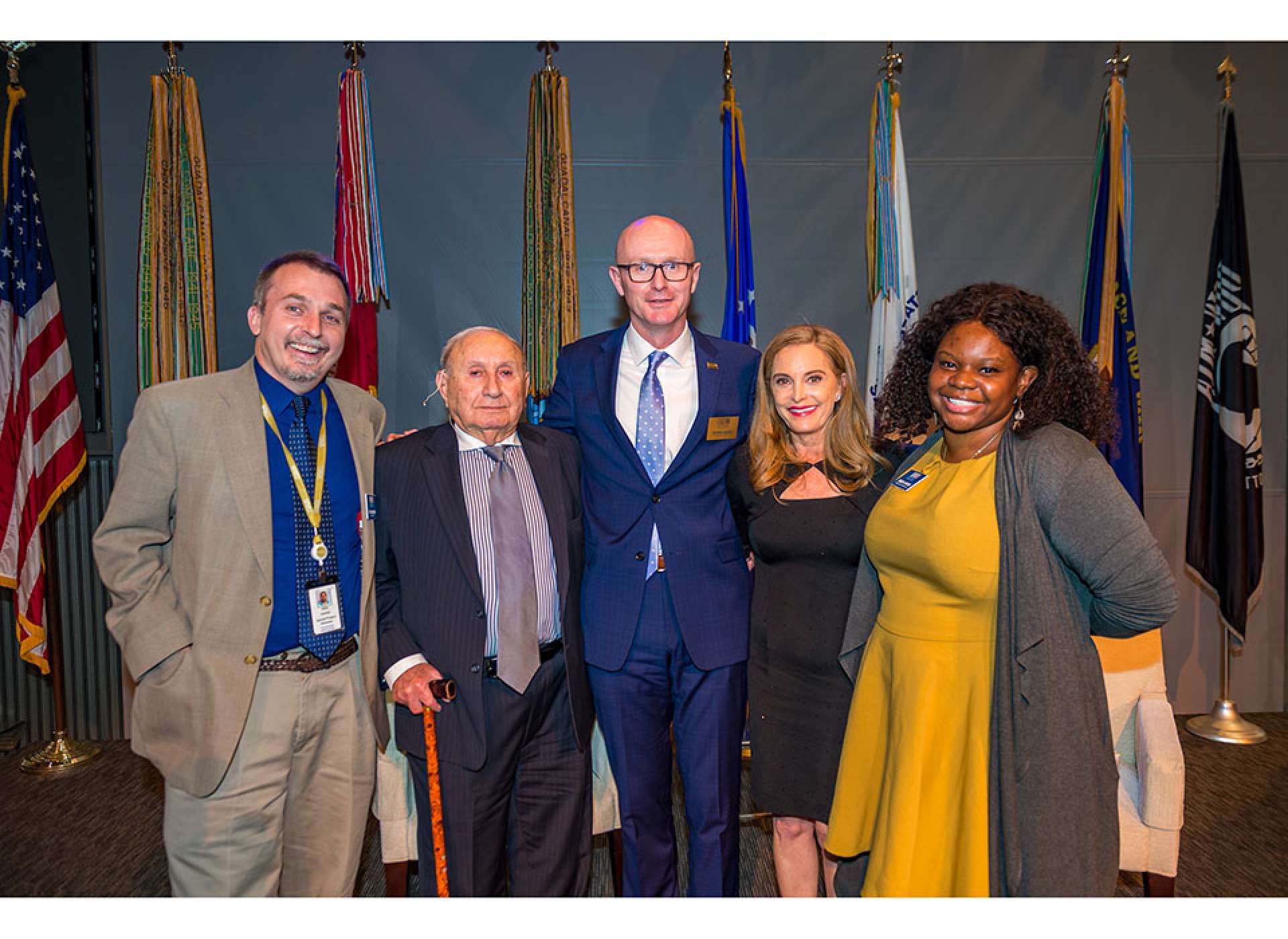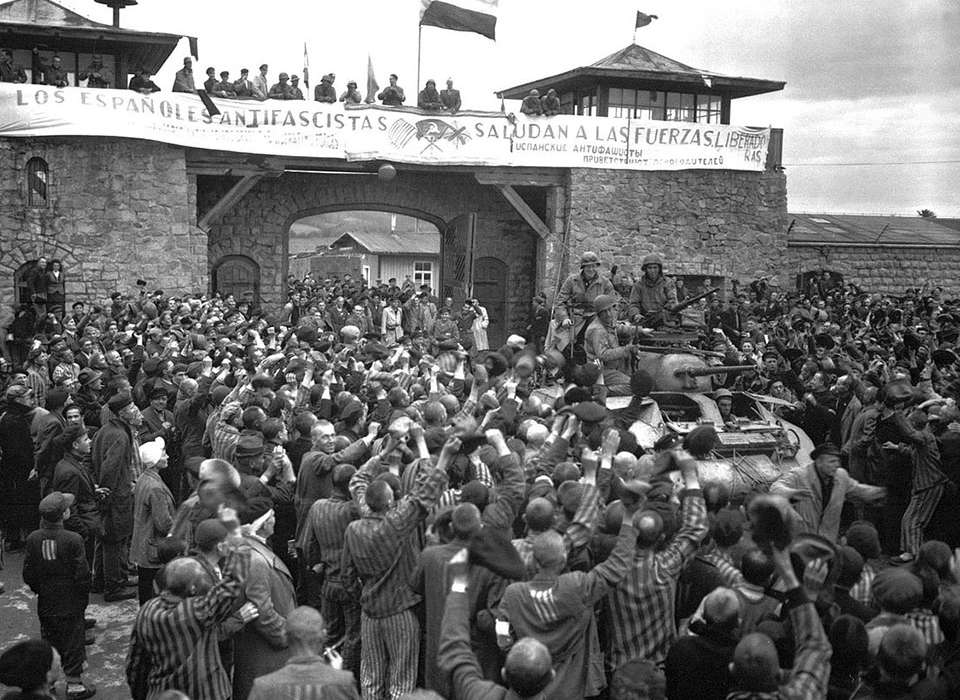Above image: Former prisoners greeting American forces in Mauthausen in May 1945. Courtesy of Cpl Donald R. Ornitz, US Army.
In its essence, in its most fundamental aspects, Nazism was defined by the demonization, suppression, and ultimately mass annihilation of groups condemned as racial and political enemies. The gigantic network of concentration and extermination camps and the killing centers of the T-4 program for the mentally and physically disabled remain the starkest reminders of this ideological core of the National Socialist regime. The system of degradation, enslavement, medical experimentation, and genocide created by the Hitler dictatorship for its adversaries was without parallel, Joseph Stalin’s Soviet Union not excepted. By comparison, the Nuremberg rallies with their massive spectacles of Führer adoration, the mobilization of Germans from all backgrounds into party organizations, and even the suppression of other parties and political perspectives all appear as secondary qualities of rule in the Third Reich.
Mauthausen was one of the worst of the concentration camps in this system. “One of the worst,” a phrase of comparison, is not used lightly here. Established in 1938 near the city of Linz in Upper Austria, it was founded, along with Flossenbürg and Ravensbrück, on orders from Reichsführer SS Heinrich Himmler, as part of an expansion of the concentration-camp network. Quickly Mauthausen acquired a reputation for lethality, even among its peer camps. With its subcamps at Gusen, Ebensee, and Melk, Mauthausen sat at the center of a web of systematic violence.
Reflecting on the liberation of Mauthausen on May 5, 1945, I do not have to refer to the work of others on this point. In July 2005 I made my own trip to the site of the camp while doing dissertation research at the Literature Archive of the Austrian National Library in Vienna. I took a morning train from Vienna via St. Pölten and St. Valentin to the town of Mauthausen, close to where the Danube and Ems Rivers converge. From there I went out to the huge camp complex which bears the same name as the town. Once I reached it, there were spectacular views of the Upper Austrian countryside accessible from several of the camp’s major sites. Rolling hills grabbed my attention. How could such a place of torment exist in such a beautiful locale? Yet it does.
Oswald Pohl, director of the SS Administration Office, and Theodor Eicke, Inspector of Concentration Camps, two men enjoying Himmler’s complete confidence, visited Mauthausen in March 1938 immediately following Nazi Germany's annexation of Austria. The granite quarries there interested them greatly. Adolf Hitler and Albert Speer’s plans for megalomaniacal construction projects required building materials beyond what German industry could then satisfy. Quarries, like those at Mauthausen or at Flossenbürg in Bavaria, Pohl and Eicke realized, could meet these new needs. Under Pohl’s leadership, the newly founded German Earth and Stone Works administered these economic ventures.
Who would do the work? The SS could count on a reserve army of concentration-camp inmates, human beings who had been stripped of all their rights. At first, Himmler, Pohl, and Eicke chose men deemed “professional criminals” and “asocials” to do the labor. In early August 1938 the first inmates set foot on the site and started construction of the camp. Although most of them bore on their uniforms a green triangle signaling their official status as criminals, the vast majority were in custody for petty property offenses. That did not matter in the slightest to Franz Ziereis, whom Eicke selected to replace Albert Sauer as Mauthausen’s commandant in February 1939.

Franz Ziereis, SS Commandant of Mauthausen. Courtesy of the National Archives & Records Administration.
The following year Spanish Republicans—socialists, communists, and anarchists—were incarcerated at Mauthausen. They would eventually number 7,000. These fighters, seized from French internment camps during the German invasion of France, had fought against Francisco Franco and his Italian and German backers in the Spanish Revolution and Civil War before fleeing north in 1939. Their courage served them well in this appalling place.
In early 1941, several hundred Dutch Jews, taken into custody shortly before the Amsterdam General Strike arrived. The SS especially relished abusing them. Ultimately Jehovah’s Witnesses, Catholic priests, and Roma, often classified among the “asocials,” joined the polyglot universe of Mauthausen. They all had but one purpose: to labor until every drop of energy was squeezed out of them.
The Mauthausen concentration camp was one of the places where an ultra-brutal form of capitalism, peculiar to the Nazis, took shape. All of the previous history of workers’ struggles for dignity, fair wages, a shorter working day, and the right to form unions and to strike were viciously repudiated by the curses of the Kapos, the crack of whips, and the shots of pistols. Days of excruciating toil frequently lasted eleven hours in the summer months and nine hours in the winter. Once they extracted blocks of stone from the cliff, the prisoners next had to break them into smaller fragments. Then they were forced to bear them up the 186 steps of the Todesstiege, the horrid Stairway of Death.
It is a difficult walk down the Stairway, even when you were only carrying a little backpack as I did. The steps are small, just big enough to accommodate my feet. Forced to carry stones often weighing more than 100 pounds up this path, the repeated ascent broke the spirits and bodies of thousands. Years after my trip to Mauthausen I read Saul Friedländer’s searing description of the story of the Dutch Jews taken into custody. These men “had to run up the 186 steps. In some instances the rocks immediately rolled downhill, crushing the feet of those that came behind. Every Jew who lost his rock in that fashion was brutally beaten, and the rock was hoisted onto his shoulders again.” The SS eagerly dispensed punishment to anyone exhibiting fatigue. During my trip, once I reached the bottom of the Stairway, I went to a pond underneath a very steep rock wall. Sharp rocks shot up through the water. A monument erected there described how the SS delighted in hurling these Jewish men off the top of this wall to their deaths. With their inimitable sense of humor, the guards nicknamed their victims Fallschirmspringer—parachutists.
These men died unspeakably painful deaths far from their homes in 1941-42. “In other camps,” writes Nikolaus Wachsmann, “inmates began to dread a transfer to Mauthausen, after returning prisoners described the huge quarries as hell on earth.” Its name rightly incited terror.
During the fall of 1941 the camp leadership ordered the construction of a gas chamber. After several months of work, the SS began to kill prisoners, condemned for political offenses, there with poison gas in March 1942. The first victims were Soviet prisoners of war transferred to Mauthausen from POW camps run by the German army. Later the SS gassed inmates who were extremely ill. Some 3,500 people were murdered with this abominable method by the war’s end. Ziereis had a crematorium installed to burn the bodies.
While touring the camp site, I saw the descriptions of the killings of prisoners in Barracks 20 with coronary injections. Subsequently, I paused by some of the photographs in the exhibit of SS men stationed at Mauthausen. The pictures capture genuine camaraderie and joy among them. These images transmit a horrible truth—bonds of friendship and group pride can assume the most perverse forms.
In some cases Ziereis and his subordinates were happy to let others do the dirty work. Starting in June-July 1941, doctors from the Hartheim killing center, part of the T-4 program, arranged meetings with camp personnel. Cooperation ensued. The SS picked out inmates determined to have mental illness or suffering from physical disabilities and transported them to Hartheim. According to Nikolaus Wachsmann, the “Mauthausen SS used a Mercedes omnibus and two yellow postal buses to ferry the victims to their deaths.” They were put to death with carbon monoxide gas.
One of the most spirited of the inmates who escaped these horrors in Mauthausen was Hans Maršálek (1914-2011). Maršálek had worked in Communist-led resistance groups in Vienna and Prague. In September 1942, 11 months after the Gestapo captured him, he entered Mauthausen. When urged by comrades to volunteer for clerical work, he recalled, in a much later interview about his time in Mauthausen, how he balked at the idea of doing anything for the vile SS. Within a few weeks, however, the sight of beatings and executions changed his mind. “If you have even a shred of decency, you pitch in and help,” Maršálek said. He rose in the Mauthausen administration, becoming camp clerk. This saved his own life but also entailed his absorption into the camp’s operations. Doing such office tasks, he remembered, “I didn’t realize that I too had become a part of this machinery of death.” Having to write Verstorben (Deceased) by the names of so many Soviet prisoners induced him in 1943 to do what he could to disrupt the murder process.
Over the next two years, Maršálek worked with several other inmates to delay executions and to spare the most vulnerable from labor. As the war turned against Adolf Hitler, hope kindled that the camp might be freed. The wait must have been agonizing as the fierce winter of 1944-45 set in.
Evacuees from Auschwitz-Birkenau, Sachsenhausen, and Ravensbrück flooded the camp during those months. They came in cattle cars, in trucks, and on foot. Typhus and malnourishment spread throughout their ranks.
One of these evacuees was Martin Baranek. In Determined, the memoir written with Lisa Cicero, and in his January 2020 presentation at The National WWII Museum, Baranek told of the horrors he saw upon arrival in Mauthausen. Once he stepped out of the cattle car, Baranek, who had already survived both the slave-labor camp at Starachowice and Auschwitz, feared the worst. “Mauthausen was unlike anywhere else, a place of physical and mental torture and abuse beyond our imaginations,” he writes. Forced to sleep in the barracks on the floor “in rows, like herring,” he goes on, new arrivals like him came to grips with the fact that “food was almost nonexistent in this camp. People fell dead around us all the time. We missed the watery soup and crumbling bread of Auschwitz-Birkenau.” Baranek would soon be moved to a construction camp at Gunskirchen. He would survive the war and is a precious witness to so many aspects of the Nazi genocide.

(From left to right) Jason Dawsey, Martin Baranek, Stephen Watson, President and CEO of The National WWII Museum, Lisa B. Cicero, and Amber Mitchell, Assistant Director of Public Engagement at The National WWII Museum. Courtesy of Frank Ayami.
Mauthausen surpassed its own earlier precedents for barbarity in the winter and early spring of 1945. Even with the Nazi regime’s days numbered, business as usual did not halt for Commandant Franz Ziereis. In late February, hundreds of escaped Soviet prisoners were rounded up, with help from local citizens—and executed during the Hasenjagd (Hare Hunt), as the Nazis called it. On April 20, Hitler’s final birthday, the SS made a “selection”—the hideous euphemism for killing—of 3,000 ill inmates from the infirmary. Then on April 28 they carried out a final gassing operation, killing more than 30 Austrian socialists and communists. Murder was a way of life for these sadists.
Yet as fanatical as they were, the SS personnel understood the war was over. They fled Mauthausen on May 3, 1945. At last, the prisoners were rid of them. An International Committee, organized by the prisoners at the end of April, took over the camp. For two days they waited for the Americans. US troops from the 41st Cavalry Reconnaissance Squadron of the 11th Armored Division, part of General Patton's 3rd Army, finally arrived on May 5. That same day Gusen and Melk fell into American hands. Men from the 80th Infantry Division moved into Ebensee on May 6. On May 7, other units of the 11th Armored Division entered Mauthausen. Photographs from this moment are stirring. A huge banner decorated with the words, “Spanish Antifascists greet the Allied forces!” towered over the column of American soldiers.
Among the liberated an American was discovered. He was Lieutenant Jack Taylor (1909-1959), an officer in the US Navy who had joined the Office of Strategic Services (OSS). Taylor, a leader of OSS operations in Greece and the Balkans providing support to partisans and escape to downed airmen, was captured by the Gestapo in late November 1944 while on a mission in Austria. Getting a rare inside glimpse of the Nazi concentration-camp system, he endured a horrendous month in Mauthausen before the liberation. The arrival of the Americans saved Taylor from certain execution. When asked by reporters what he experienced, Taylor related the starvation, physical abuse and killing perpetrated by the guards. “Fortunately my turn hadn’t come,” he said. Taylor not only lived to tell the press about Mauthausen, he resolutely sought justice for the victims. Pictures snapped in May 1945 show him explaining the operation of a gas chamber. He also authored a report on his time in the camp and in the spring of 1946 testified in a trial of Mauthausen personnel at Dachau that brought death or prison sentences for all 61 of the accused.
Maršálek praised the United States forces for their diligence in tending to the sick. There were thousands who needed the most urgent care. The Americans transported some to local hospitals, others to nearby schools. They had to procure cots, blood for transfusions, supplies of glucose for injections, and absolutely vital anti-typhus medication. At the beginning these efforts were improvisational, but the best that could be done under the terrible circumstances. Over 1,600 former inmates still required medical attention into June 1945.
Yet they could not save everybody. Having tasted freedom, several thousand died in the days after May 5. It was an unimaginable end for men so close to new, better lives. Over 3,000 of them were interred in the grounds next to the Mauthausen and Gusen facilities.
Stunningly, Ziereis did not immediately flee the vicinity of the camp. On the contrary, he later claimed to have watched through his field glasses as the Americans accepted the surrender of SS units. Perhaps the long years of brutality he oversaw as commandant had degraded his mental capacities. A few weeks after Mauthausen's liberation, someone laid eyes on Ziereis near his hunting lodge. When American soldiers attempted to arrest him, he opened fire on them. Shot in the process, Ziereis had little choice but undergo questioning by American interrogators and by Maršálek in the 131st US Evacuation Hospital. Before this arch-criminal expired from his wounds on May 24, 1945, he shifted blame for what transpired in Mauthausen to his superiors in the SS and the Nazi Party. After he died, his corpse was decorated with swastikas by former inmates and unceremoniously hung on the fence of the Gusen subcamp.
From August 1938 until May 1945, Mauthausen was a site of torment, slave labor, and mass death. For 90,000-95,000 people, liberation came far too late. With many comrades and friends, Hans Maršálek devoted much of his long postwar life to establishing and maintaining a memorial at Mauthausen for the murdered, as well as documenting in print the history of the camp. The brilliance of the work he and others began in the immediate postwar years goes straight to the visitor’s heart. Among the many memories I occasionally tap from my trip was the sight of the Spanish, Soviet, Bulgarian, Romanian, Hungarian, Polish, and Italian monuments to their dead. The inscriptions stress the Nazis’ annihilation of human beings from across Europe who stood against their racial-political vision—but also the defiance and refusal to succumb to Hitler, Himmler, and Ziereis.
Further Reading
Baranek, Martin, with Lisa B. Cicero. Determined: A Memoir. Denver: Outskirts Press, 2018.
Friedländer, Saul. Nazi Germany and the Jews, 1939-1945: The Years of Extermination. New York: Harper Perennial, 2007.
Stone, Dan. The Liberation of the Camps: The End of the Holocaust and its Aftermath. New Haven: Yale University Press, 2015.
Wachsmann, Nikolaus. KL: A History of the Nazi Concentration Camps. New York: Farrar, Straus, and Giroux, 2013.

Determined: A Memoir
View Martin Barbanek's memoir on the Museum Store. Every Museum Store purchase helps fund the education mission.
This article is part of an ongoing series commemorating the 75th anniversary of the end of World War II made possible by Bank of America.
Jason Dawsey, PhD
Jason Dawsey, PhD, is ASU WWII Studies Consultant in the Jenny Craig Institute for the Study of War and Democracy.
Cite this article:
MLA Citation:
APA Citation:
Chicago Style Citation:






![Max Fuchs, New York City cantor, sings as Rabbi Sydney [sic] Lefkowitz, Richmond, VA, conducts the first Jewish services from Germany.](/sites/default/files/styles/max_650x650/public/2025-10/image1.jpg)



